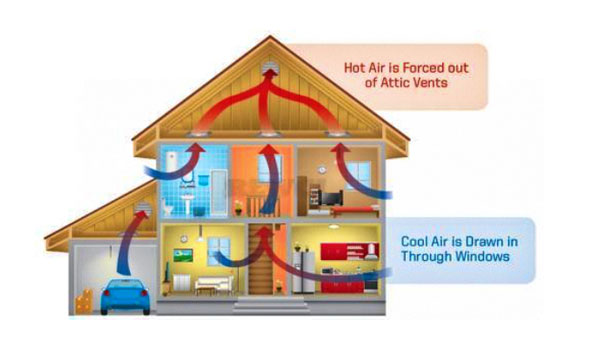Whole-house fans
By Lisa Nicklanovich; courtesy graphic

Resident Peter Cline noticed his electricity bill going up and decided to have a whole-house fan installed. Not only does a whole-house fan use much less energy than an air conditioner (AC), there are other benefits too.
A whole-house fan is a ventilation cooling system that works by pulling cool, outdoor air into a home, and then venting it out attic vents. This energy-efficient system can extend the life of an existing AC system by decreasing its usage, and for many people, the fresh air brought into their homes by a whole-house fan is welcome. Often, fans are quieter than AC units as well.
To bring fresh, cool air in and push hot, stale air out, the temperature outside has to be cooler than the temperature inside. Cline, like many homeowners with whole-house fans, uses his in the evenings and throughout the night. It takes time to pull the heat out of a structure, so by ventilating throughout the night, the house starts the next day cooled to the core, which delays or eliminates the need for AC. Whole-house fans usually do their job best in the spring and fall. In the hotter summer months, whole-house fans are then used in conjunction with AC.
Cline said, “The vents are as important as the fan.” It’s essential to have the right amount of venting in the attic for the size of the house. Without the right number of vents, pressure can build up, slowing down airflow and reducing efficiency, potentially pushing hot attic air back into the living space. It’s also critical to have windows open when using a whole-house fan. Without windows open, negative pressure can be created potentially causing dangerous backdrafting. Cline said, “With the windows open, you can feel the air moving; if you put your hand in front of the open window, you can feel the air coming in.”
A reputable whole-house fan installer can calculate the number of vents needed based on measuring airflow in cubic feet per minute (CFM). The higher the CFM, the more venting area is required to keep the system working efficiently.
Cline had three vents added in his attic along with the fan and he considers the cost worth it for the savings in energy, the improvement in indoor air quality and the quiet hum of the fan versus the loud AC.
If the outdoor air quality is poor – if there has been smoke from wildfires – that would not be a good time to use a whole-house fan. Also, people with allergies may suffer from having pollen-filled air pulled into their homes.